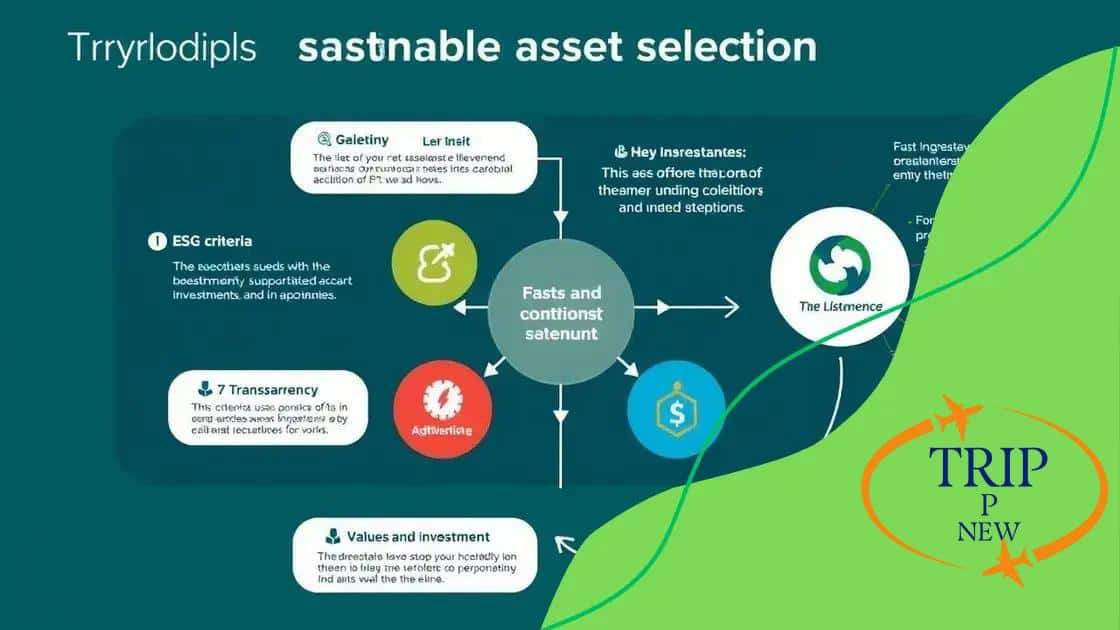How to incorporate sustainability into your investment approach

Anúncios
Sustainable investing involves selecting investments that prioritize environmental, social, and governance (ESG) factors, providing financial returns while positively impacting society and the environment.
How to incorporate sustainability into your investment approach might seem like a daunting task, but it can actually be quite rewarding. Have you ever considered how your financial choices impact the world around you? Let’s explore some essential strategies for blending sustainability into your investment plans.
Anúncios
Understanding sustainable investing
Understanding sustainable investing is crucial for anyone looking to make a positive impact with their financial choices. It’s about aligning your investments with your values and the future of our planet.
At its core, sustainable investing focuses on generating financial returns while also considering environmental, social, and governance (ESG) factors. This approach not only seeks to do good but also recognizes that companies with sustainable practices often perform better in the long term.
Key Concepts in Sustainable Investing
Several key concepts define sustainable investing. These concepts can help you navigate this growing field:
Anúncios
- Environmental impact: Evaluating how investments affect the environment, such as carbon emissions and resource depletion.
- Social responsibility: Considering how companies treat their employees, communities, and stakeholders.
- Corporate governance: Assessing how a company is managed, including transparency and ethical practices.
By incorporating these elements, investors can shift their focus to businesses that contribute to a sustainable future. For example, companies committed to reducing their carbon footprint often attract more investors, which benefits both the planet and the bottom line.
Why Choose Sustainable Investments?
Choosing sustainable investments can offer numerous benefits. Not only do they help address global issues, but they often yield competitive returns. Many investors find that aligning their portfolio with their values leads to greater satisfaction in their investment choices.
Sustainable investing has gained momentum, and as more investors demand it, companies are encouraged to adopt better practices. This creates a positive feedback loop where responsible companies thrive, and investors see promising returns.
Additionally, transparency and accountability are becoming more pronounced in the investing world. Investors can now access extensive ESG data, which makes it easier to make informed decisions about their investments.
How to Start Investing Sustainably
If you are eager to start investing sustainably, consider these steps:
- Research companies and funds that emphasize ESG factors.
- Review your current investment portfolio to see where changes can be made.
- Consult with financial advisors who specialize in sustainable investing.
- Stay informed on trends and regulations in sustainable finance.
Understanding sustainable investing not only helps you align your financial goals with ethical considerations, but it also positions you to participate in a growing market trend. By choosing investments that promote sustainability, you’re contributing to a healthier planet while pursuing your financial objectives.
Benefits of a sustainable investment strategy
The benefits of a sustainable investment strategy are numerous and impactful. By choosing to invest in companies and projects that prioritize sustainability, you not only contribute to environmental preservation but also stand to gain financially.
One of the primary benefits is the potential for long-term financial returns. Companies that implement sustainable practices often outperform their peers. This is because they are better prepared to handle risks related to environmental changes and social responsibilities. As such, sustainable investments can lead to higher profitability over time.
Enhanced Risk Management
Investing sustainably also enhances risk management. Here are a few reasons why:
- Lower volatility: Sustainable companies often exhibit lower stock price volatility, making for a more stable investment.
- Regulatory compliance: These companies are more likely to comply with government regulations, reducing legal risks.
- Reputation protection: Businesses focused on sustainability are less vulnerable to negative publicity.
Moreover, as more consumers prefer products and services from responsibly-run companies, investor interest in sustainable firms increases. This leads to greater demand for their stocks, which can enhance their market value.
Positive Social Impact
Another essential benefit is the positive social impact. By investing sustainably, you’re contributing to social goals such as:
- Improving community health and wellbeing.
- Promoting fair labor practices.
- Supporting renewable energy initiatives.
These investments can help drive the transition to a more sustainable and equitable society. Investors can feel good knowing their money is supporting initiatives that align with their personal values.
Furthermore, sustainable investing helps in creating long-term wealth that supports eco-friendly practices. It enables investors to participate in the growth of sectors like clean technology, which are integral to addressing climate change.
Key principles of sustainable asset selection

The key principles of sustainable asset selection are essential for investors who want to make a positive impact while achieving financial returns. By following these principles, you can ensure that your investments align with your values and contribute to a sustainable future.
One important principle is the focus on long-term value. Sustainable investing encourages looking beyond short-term profits. Investors should consider how companies manage resources and their exposure to environmental risks. These factors can significantly influence a company’s long-term viability and success.
Environmental, Social, and Governance (ESG) Criteria
Another foundational aspect of sustainable asset selection involves integrating ESG criteria. Evaluating companies based on:
- Environmental impact: Assessing how a company’s operations affect the environment.
- Social responsibility: Understanding how a company engages with its employees and community.
- Corporate governance: Considering leadership quality and ethical practices.
By using these criteria, investors can identify companies that are committed to sustainability. This commitment often leads to better management practices and reduces risk.
Transparency and Reporting
The principle of transparency is also critical. Companies that provide clear and detailed reports about their sustainability practices allow investors to assess their commitment to ESG standards. When assets are selected based on transparency, it fosters trust and confidence in the investments.
In addition, investors should seek out firms that prioritize regular communication regarding their sustainability efforts. This ongoing dialogue can help investors stay informed and engaged.
Lastly, aligning investments with personal values is a vital principle. Many investors prefer companies that reflect their beliefs about social justice, environmental conservation, and ethical governance. By focusing on companies that resonate with their values, investors can feel a deeper connection to their portfolios.
Incorporating these principles into sustainable asset selection enables investors to make informed choices that align with their financial objectives and ethical priorities. This harmonious approach not only benefits individuals but also supports the broader goal of creating a sustainable economy.
Tools and resources for sustainable investors
There are many tools and resources for sustainable investors that can help guide your investment choices. These resources make it easier to identify companies that adhere to sustainable practices and contribute positively to society while aiming for financial returns.
One of the most valuable resources is sustainability ratings. Many organizations evaluate companies based on their environmental, social, and governance (ESG) performance. These ratings provide insight into how well a company is managing its sustainability initiatives. Popular platforms for these ratings include:
- Sustainalytics: Offers comprehensive ESG ratings and research.
- MSCI ESG Ratings: Provides insights into a company’s ESG risks and opportunities.
- FTSE4Good Index: Helps investors identify companies with strong sustainability practices.
Using these ratings allows investors to make informed decisions about where to allocate funds. Furthermore, sustainable indices like the Dow Jones Sustainability Index serve as benchmarks to assess the performance of companies engaged in sustainable practices.
Investment Platforms
There are also dedicated investment platforms that focus on sustainable assets. Many of these platforms allow you to invest in funds that prioritize sustainability:
- Betterment: Offers socially responsible investing options.
- Wealthsimple: Provides sustainable investment portfolios.
- Raise Green: Focuses on green bonds and renewable projects.
These platforms often provide educational resources to help investors understand sustainable investing better. They make it easy to diversify your portfolio while staying true to your values.
Networking and Community Resources
Joining networks and communities can also enhance your sustainable investing journey. Engage with platforms like Greenfin: and Investors for Openness and Accountability. These organizations connect investors and advocate for sustainable finance.
Participating in webinars, workshops, and conferences can provide further insights and keep you updated on the latest trends in sustainable investing. By utilizing these tools and resources, you can align your investments with your personal values and contribute to a more sustainable future.
Real-world examples of successful sustainable investing
Many real-world examples of successful sustainable investing demonstrate how aligning financial goals with environmental and social responsibilities can lead to impressive outcomes. Companies across various sectors are thriving while prioritizing sustainability.
One notable example is Unilever. This consumer goods giant has focused on sustainability for years. Their Sustainable Living Plan sets ambitious goals to decrease their environmental impact while increasing social benefits. By promoting products with reduced environmental footprints, Unilever has not only attracted eco-conscious consumers but also seen profitable growth.
Case Study: Tesla
Tesla is another prime example. As a leader in electric vehicles, Tesla’s commitment to sustainability resonates with investors. The company focuses on reducing greenhouse gas emissions through innovative technology.
Investors have flocked to Tesla due to its growth potential and commitment to a sustainable future. By supporting sustainable technologies, Tesla has experienced significant market value increases, benefiting both the environment and its shareholders.
Impact Investing: The Rise of Green Bonds
Impact investing has gained traction through projects like green bonds. These bonds finance initiatives that contribute to sustainability. For instance, the issuance of green bonds by governments or corporations helps fund renewable energy projects.
The World Bank has issued green bonds to support climate-friendly projects. This step has attracted investors who are interested in financing initiatives that lead to positive environmental changes.
Examples such as these show that sustainable investing can generate substantial returns while supporting necessary environmental advancements. Investors who align their portfolios with sustainable practices can benefit not only financially but also contribute to a better future.
In summary, by focusing on sustainable practices and innovations, companies and investors can create win-win scenarios where profitability and sustainability coexist. Many more organizations are following in their footsteps, showing that responsible investing is possible.
FAQ – Frequently Asked Questions about Sustainable Investing
What is sustainable investing?
Sustainable investing involves selecting investments that prioritize environmental, social, and governance (ESG) factors, aiming for both financial returns and positive societal impact.
How can I start investing sustainably?
You can start by researching companies that prioritize sustainability, using investment platforms that focus on ESG criteria, and utilizing sustainability ratings for informed decision-making.
What are some benefits of sustainable investing?
Benefits of sustainable investing include potential high returns, positive environmental impact, support for social responsibility, and growth potential for sustainable products.
Are there specific tools to help with sustainable investing?
Yes, there are various tools and resources, such as sustainability ratings, investment platforms, and community networks that provide valuable insights for sustainable investors.





